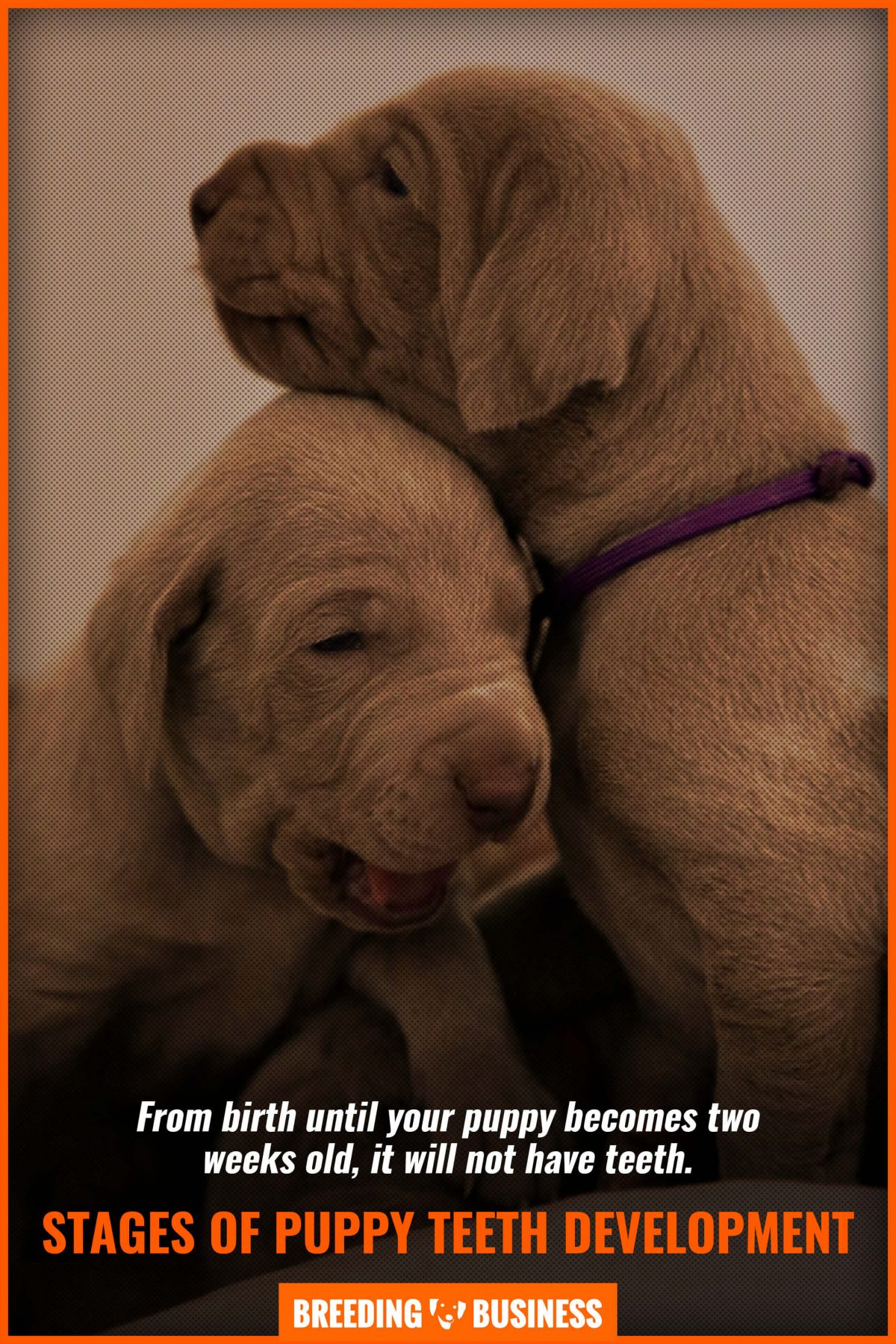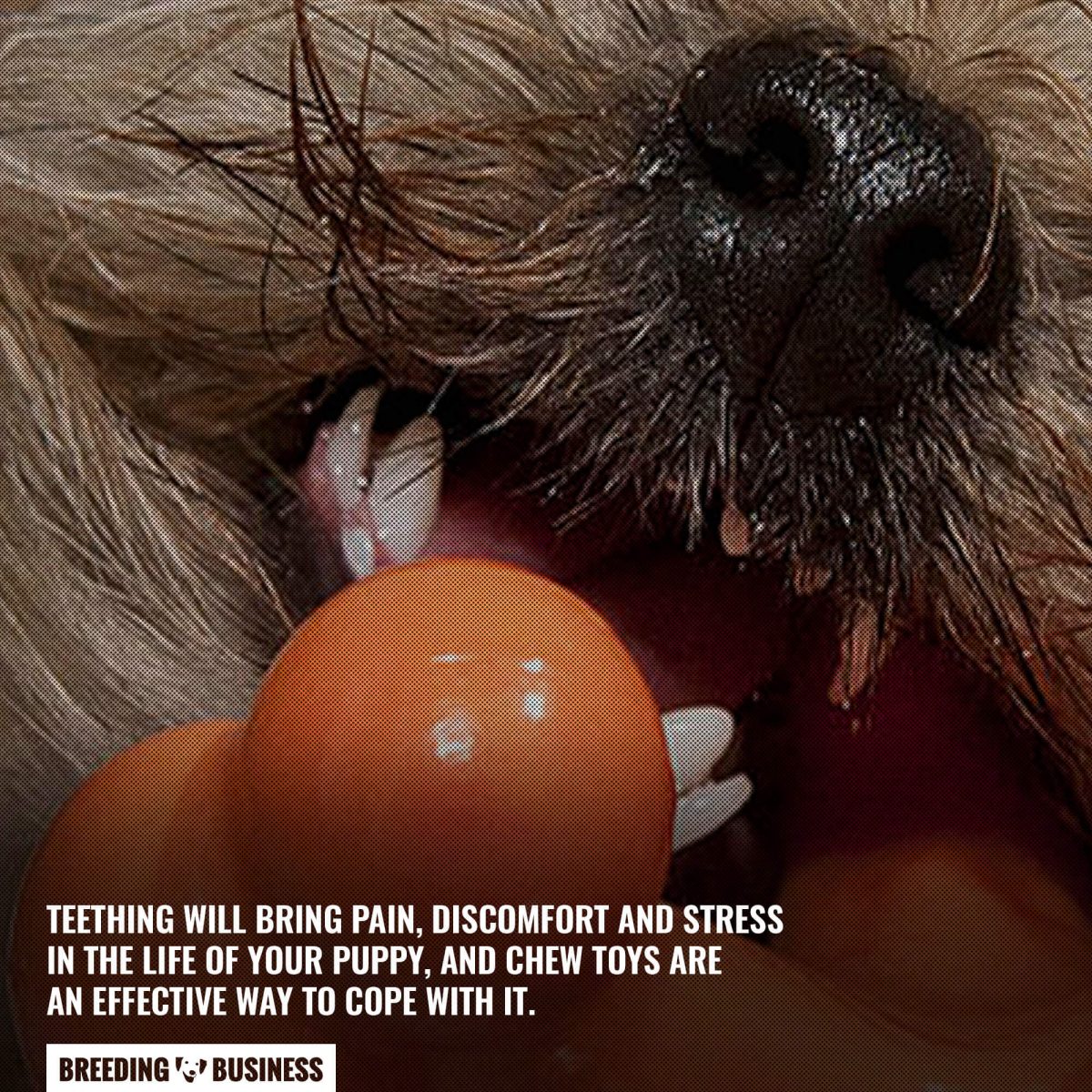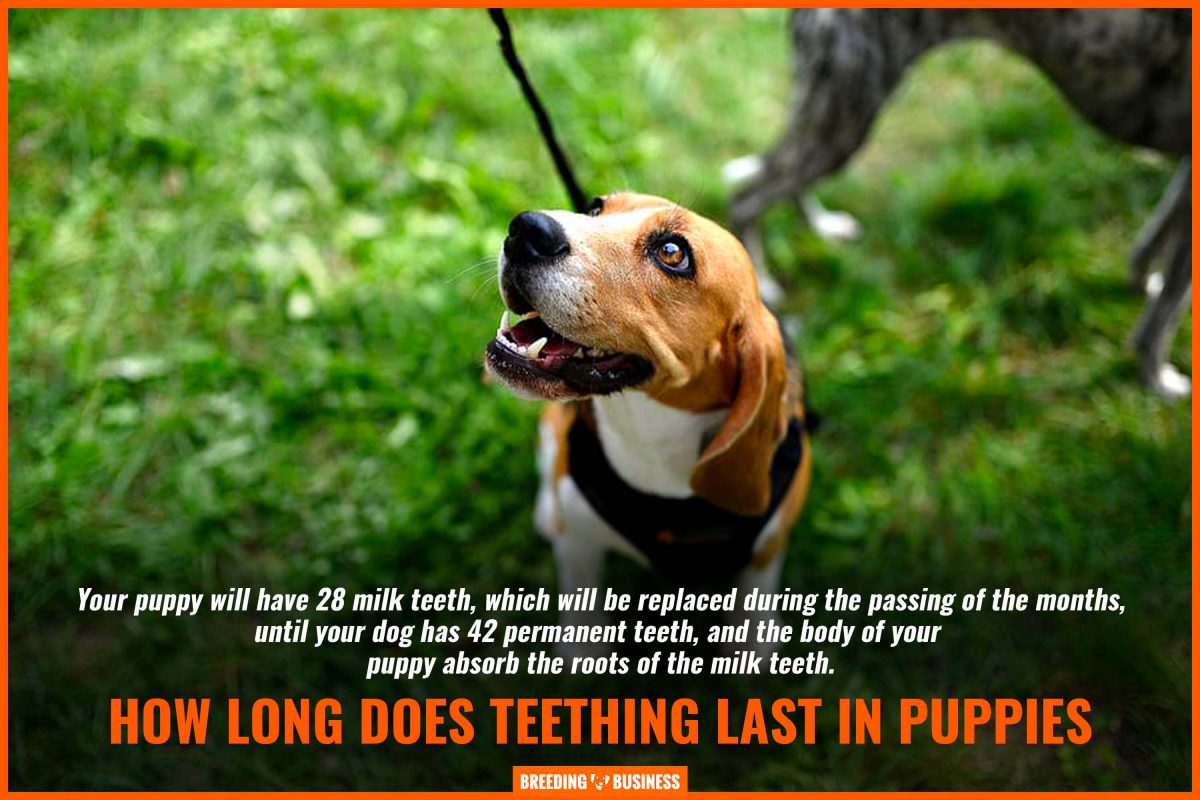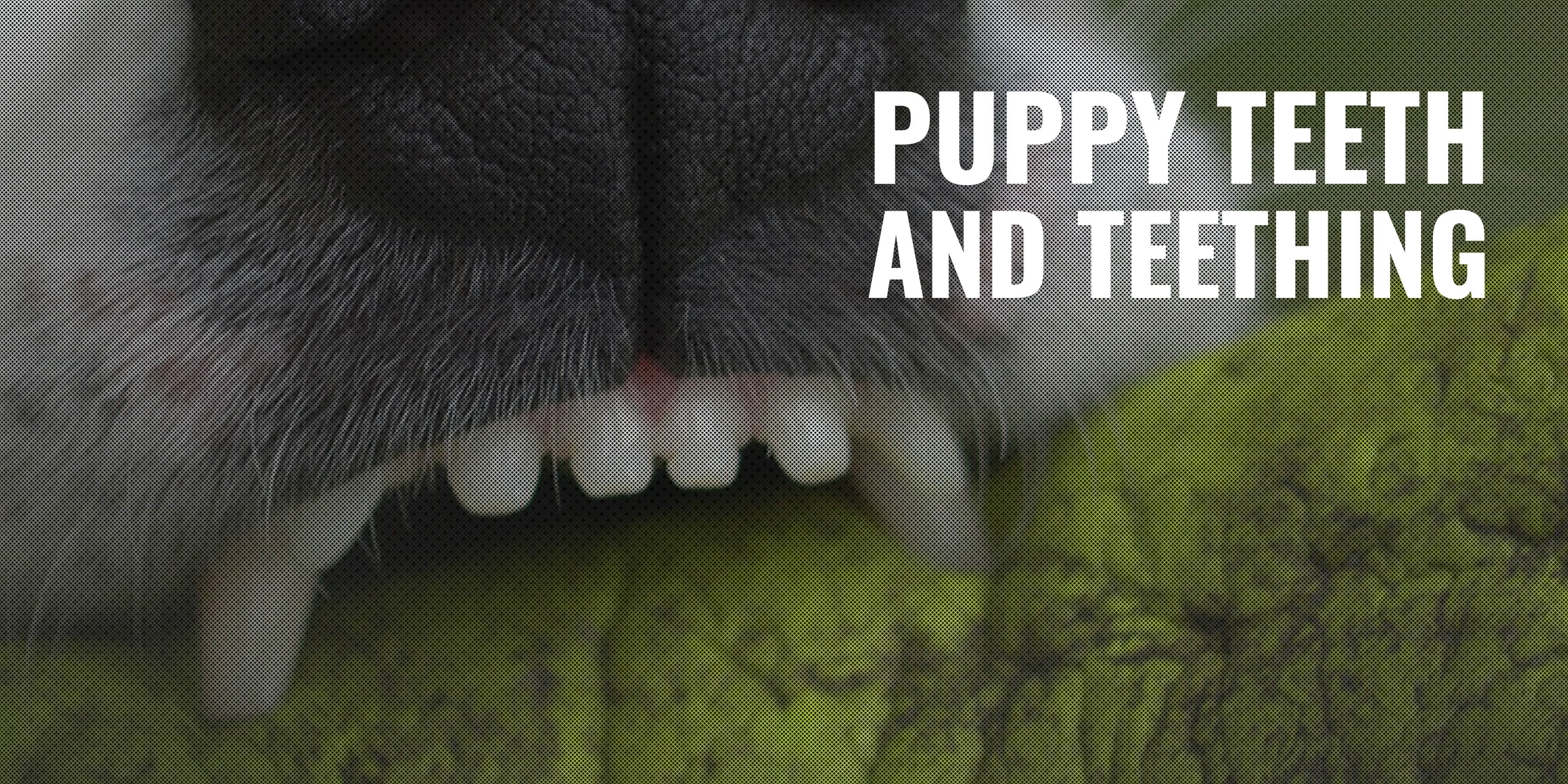Learn everything about puppy teeth and teething with the best guide on the internet. It will explain to you the entire process in layman’s terms and you can find exclusive insight and teachings into you how to keep the teeth of your puppy in an optimal state.
You are going to learn when puppy teething is at its worst, what the symptoms of teething are, and what toys will help your pet to have an easier time. Also discover answers to the most frequently asked questions relating to puppy teeth.
Stages of Teeth Development in Puppies
Let us start by learning about the different stages of teeth development in puppies, so you see how long it takes and what cares to take during each phase. To bring you a general overview, your puppy will have 28 temporary teeth during this phase, which also receive the name of puppy/milk teeth.
Stage 1: Week 2 To 4
From birth to two weeks old, your puppy will not have teeth. Then from two weeks of age to four, the following teeth will begin to emerge:
- Incisors: They are the first to appear, you will find 6 of them on both the top and the bottom of the jaw
- Canines: They tend to appear by the end of week 4 and they are thinner than the canines of an adult dog. They will grow next to the incisors – both on the top and the bottom – in consequence, framing them
- Premolars: They grow behind the canines by week number 3, at the back of the mouth of your puppy. There are three on each side, both on the bottom and top jaw
- Molars: Your puppy will develop its permanent molars during week number 3, three on each side of the bottom jaw, and two on the top jaw
Remember that they are milk teeth, and hence, your puppy will replace them in the following weeks. Nonetheless, even at this age, you can see that your puppy has been designed to obtain its protein from meat. These teeth are designed for tearing and chewing meat and therefore you need to make sure you are providing such a diet.

Stage 2: Weeks 5 To 8
During this time frame, your puppy will have all of its 28 milk teeth. After that, the process of replacing them with adult teeth begins, and therefore, your puppy may experience discomfort and pain. When your puppy becomes eight weeks old, the permanent teeth will begin to push out the milk teeth, and in the meanwhile, the body will absorb the roots of the baby teeth. Nonetheless, some puppies experience problems during this phase because they are not capable of pushing out the puppy teeth. If this happens, your dog will have a double set of teeth.
If you face this situation, you will have to take your puppy to the veterinarian because the remaining milk teeth will have to be extracted. It will allow the permanent teeth to emerge and develop properly. Therefore, you should check that your puppy has the full 28 milk teeth by week 5 to 7, and from week 8 you should pay attention to the permanent teeth emerging and the puppy teeth falling out. In case your pet presents complications, you will have to take it to the veterinarian. It is critical because if you allow your pet to have a double set of teeth, then it will lead to problems with teeth alignment, an issue that has all sort of complications including:
- Problems when eating, and consequently, malnourishment
- Inadequate oral hygiene
- Discomfort and pain
- Periodontal disease
In consequence, you must take the matter seriously as an owner.
Stage 3: Weeks 12 To 16
During week 8 your puppy will begin to lose its milk teeth and replace them with permanent adult teeth. The process can last several weeks, usually up to weeks 12 and 16. This period is the most painful for your puppy. To help them cope with the pain and discomfort, you should bring it some chew toys or bones like lamb and goat. Remember to watch out closely to check if your dog still retains some milk teeth, because you need to extract them as soon as possible. As always, visit your veterinary if you ever faced such a scenario.
Stage 4: 6 Months And Above
By 24 weeks of age, your puppy should have lost all of its milk teeth, and it should have the full 42 permanent teeth; however, it can take up to four weeks more. The top jaw has 20 teeth, whereas the bottom jaw has 22 teeth. The distribution is the following:
- Incisors: 12 in total, 6 on both the bottom and top jaw
- Canines: 4 in total, 2 on both the bottom and top jaw
- Molars: 10 in total, 6 on the bottom jaw and 4 on the top jaw
- Premolars: 16 in total, 8 on both the bottom and the top
As always, monitor how the teeth develop during this timeframe, so you can get professional help in case it is necessary.
How to Avoid Puppy Teething Issues
Teething is natural but it comes with issues and side effects that will make your puppy uncomfortable. Therefore, let us see how to help it cope with this natural process, with some practical tips that you can put in practice.
Reliable Chew toys
Teething will bring pain, discomfort, and stress in the life of your puppy, and chew toys are an effective way to cope with it. In addition to helping your pup, you will prevent it from destroying your home. Chew toys will allow your dog to relieve oral irritation and the pain induced by teething. The best choices for your pet are:
- Rope toys
- Rubber toys
- Nylon toys
- Tasty bones
- Cold chew toys (Pit allows your puppy to enjoy the cold which brings a lot of relief to the gums)
As your pup will undergo a lot of stress, it would be a good idea to opt for a scented chew toy, since a study has shown that they improve their wellbeing noticeably better than non-scented toys. Our tip here is to buy at least two types of chew toys so you can let your pup decide which one it likes the most. Alternatively, you could bring it a lamb or goat bone, which is a great option because they are hard enough to chew, but not as dense as bison or beef. Other natural toys are ice cubes and frozen carrots, which are excellent for the gums.

Good Diet
The diet of your puppy can be a great source of relief too, and on top of bringing it enough protein and nutrients, you need to soften the texture. If you are feeding it a homemade diet, which mainly consists of cooked or fresh foods, then you will have an easier time. In case you are feeding it kibble, then you can take two routes:
- Soak the kibble in warm water for 10 minutes before serving. The ideal amount of water ranges from 1/8 to 1/4 of a cup
- Combine the kibble with moist/wet food, for example, canned food. It will help you to soften the dry food, and hence, bring your pet an easier time when eating it
Instead of water, you could use bone broth, which has excellent health benefits for your dog, especially during this stage. It brings your dog the following nutrients:
- Vitamin B-12
- Glucosamine
- Vitamin B-6
- Iron
- Vitamin D
- Potassium
- Vitamin C
- Thiamine
- Vitamin K
- Chondroitin
- Thiamine
- Calcium
Just a sample of the many benefits that bone broth, in addition to regular puppy food, can do for your pet!
Puppy Proofing
As we explained before, during the teething period, your puppy can become highly destructive due to the pain, discomfort, and stress that they undergo. Therefore, you need to puppy-proof your home. You already know that chew toys are a great way to cope with it, along with improving the food of your puppy. However, you will stay face scenarios where your pup will chew and bite items that it should not, like your shoes.
When it happens, remember to say “no” in a firm tone and rapidly proceed to replace the item with a chew toy. This is so your pup understands that it is only allowed to bite and chew its toys.
Functions of Puppy Teeth
Every teeth type has a specific function, and below you are going to learn about them in detail. You will also learn why puppies and dogs, in general, are designed to eat specific types of food.
Incisors
Incisors are located at the front of the mouth of your pup and they are single-rooted. Their function is scraping and nibbling, thanks to their hard biting surface. For example, your pup will use them to strip meat off a surface like a bone, as their surface is ideal. However, if your dog had to bite an empty bone, then it would not use their incisors, as they are not useful.
However, their function also extends to grooming, picking up objects, and scooping. For example, incisors, thanks to their surface, are excellent for removing furs from the coat of your pet. Just watch it, especially if your dog has a dense and long coat, and you will see that your pet will do it repeatedly. It is worth noting that, when they are affected by periodontal disease, the incisors become mobile, and hence, they have a higher chance of falling out.
Canines
Canines are sharp and pointy and they sit right next to the incisors. They allow your dog to eat meat, and in the past, they played a fundamental role in their survival, as it allowed them to inflict damage to their prey and attackers. Therefore, without canines, dogs would have never survived. In the last sub-section, you are going to see that they complement perfectly with carnassial teeth, and hence, both types of teeth support the claim that dogs should obtain most of their protein from animal meat.
Fundamentally, your dog will use them to grip and tear food. Next time you feed it with meat, just watch how it uses them to grip its food and then proceed to tear it. When your dog is still a puppy, they will look needle-like. However, the function of the canines is structural also, because they hold the tongue and act as a cradle. Furthermore, they bring strength to the rostral mandibles. Therefore, losing the canines from the low jaw would result in the tongue falling out the mouth and weakening both rostral mandibles.
Premolars
The premolars are located behind the canines and they exhibit sharp edges. Your dog will use them to break food into small pieces, and therefore, they play a fundamental role. As your dog tears the food off of any surface along with its canines, the premolars have the function of reducing them into more digestible pieces.
When you give your pup a chew toy, you will notice that it will use its premolars primarily. This is because they have also been designed for chewing, due to their serrated blade surface. In addition, your dog may also use premolars for holding and carrying objects, thanks to their sharp edges and that there are more of them.
Molars
Molars are located at the back of the mouth of your puppy and they exhibit a flat shape. Thanks to their shape, they are ideal for grinding and crushing food. For example, when you feed your dog kibble, it will use its molars to crush it down. They are exceptionally powerful because their passive bite ranges from 300 to 800 psi (pounds per square inch), and when they snap the jaws shut, they can register as much 30,000 to 80,000 psi.
Thanks to their power, dogs can crush all sorts of objects with them. For example, mother dogs use them to snip off the umbilical cord of the puppy, thanks to their exceptional masticatory force. Molars are more susceptible to caries, and therefore, you need to target them specifically when brushing the teeth of your puppy.
Carnassial Teeth
The carnassial teeth are the first moral from the bottom jaw and the upper fourth premolar. They are different from other teeth because they have three roots, and their pointy, sharp and large appearance, allows the dog to shear meat, which makes it much more efficient at consuming and digesting meat.
In essence, the carnassial teeth are modified molars and they are characteristic of carnivores. Unlike other teeth, their only function is shearing meat and bone. Similarly, they can produce a lot of masticatory force. Carnassial teeth are the ideal way to see that dogs have been born to eat meat as their main source of nutrition because evolution has adapted their dental structure to be ideal for this purpose.
How to Avoid Puppy Nipping?
Many new owners complain about puppy nipping, and even though it is completely normal, you must correct it. To do it, only put the following steps in practice:
- Allow your puppy to bite your hand as usual
- When it applies too much pressure, give a loud yelp, showing it that its action has hurt you
- After that, let your hand go
Repeat it any time your puppy does it until it learns that it hurts, and therefore, is not acceptable. In case your puppy does not react to this, then you can take another angle:
- When your puppy bites you too hard, show it that it has hurt you
- Stand up and walk away from it
- Ignore your puppy for 1-2 minutes
- In case your puppy follows you and keeps nipping, leave the room for 1-2 minutes
It will allow you to reinforce the message that nipping is not acceptable, and that if your puppy does it, then it will not receive attention or affection. You need to do it as soon as you notice the behavior. However, follow the procedure as we have detailed it, and avoid screaming to your dog, as it will not get across the right message.

How To Keep a Puppy’s Teeth Clean?
To keep your puppy happy and healthy, it is essential to clean its teeth properly. Below you will learn how to do it.

Visit the Vet
Visiting the vet is the best way to ensure that the teeth of your puppy remain clean and healthy. Because plaque tends to build up, and calculus, tartar, and stains tend to appear, you will need more than a simple brush to remove them.
Therefore, every time you visit the veterinary, make sure that your puppy receives proper dental treatment, to remove plaque buildup as well as calculus and calcification. This can lead to tooth demineralization due to the growth of bacteria.
By brushing the teeth of your puppy properly, as well as using special substances to remove tartar, calculus, and plaque buildup effectively, you can prevent poor dental outcomes. In addition, the veterinarian will also look for signs of arising oral disease, so your puppy can receive prompt treatment. It is essential to visit the vet because most dogs will not allow you to brush its inner teeth and gum surfaces, and therefore, a professional has to do it.
Brushing
Brushing the teeth of your puppy is the best way to remove the buildup of plaque, tartar, and calculus, which as we have seen, leads to dental diseases such as tooth decay, tooth demineralization, and even gingivitis. When you visit the veterinarian, ask him/her to give you a recommended toothbrush and toothpaste, and once you have one, follow these steps to do it correctly:
- Lift the lip to let you see the exterior surfaces of the teeth and gums of your dog
- Begin to brush with slow, gentle, and circular motions
- Reach all the regions of the mouth, including the canines and upper molars
- If possible, try to brush the inner regions
Once you are done, bring your puppy affection, playtime, and even a healthy treat. So that your pet can attach positive feelings when you brush its teeth.
Dry Food
Dry food is often advertised as a way to keep the teeth of your dog clean and fresh, and even though it does to some extent. It is not the best way because it only removes plaque near the tops, but when it comes to the gum line, it is ineffective.
Therefore, even though dry food helps, it should be just an add-on. The best way to protect the teeth of your puppy is regular teeth brushing and dental checkups with the veterinarian. Instead of relying on dry food, you could supplement the diet of your puppy with lamb and goat bones, which are hard and abrasive enough to clean the teeth of your pet, but without the excessive density of beef bones.
Puppy Teething – FAQs
Because puppy teeth and teething are popular topics amongst new owners, they ask many frequent questions, and therefore, we decided to answer them.
How Long Does Teething Last in Puppies?
It lasts between seven to six months. It begins when your puppy becomes two weeks old, as the first milk teeth start to emerge, and from then on, it is a long process. Your puppy will have 28 milk teeth, which will be replaced during the passing of the months until your dog has 42 permanent teeth, and the body of your puppy absorb the roots of the milk teeth.
Once all the milk teeth have been pushed out, and the permanent teeth have fully developed, you can officially say that teething has finished for your dog. It takes from six to seven months, but under some circumstances, it can take up to eight months.

Do a Puppy’s Teeth Hurt When Teething?
Puppy teething is uncomfortable but can also be painful. It happens because the milk teeth will emerge through the gums, resulting in pain, which can range from mild to severe. Your pup may be verbal and the best way to bring it relief is by buying it good chew toys.
Soothing the pain of your puppy is essential during this period because not all dogs are the same, and therefore, yours may experience more painful teething. Buying it good chew toys and making its food softer are the best measures to help your puppy cope with the pain and discomfort.
How can I Help my Puppy With Teething?
You can help your puppy with teething, and you can do it two ways: bring it several chew toys and make its food softer. In the case of toys, you should buy it different types of toys, for example, ropes, rubber toys, tasty bones, nylon bones, and cold chew toys.
Furthermore, either you should switch it to a diet consisting of soft food, such as homemade meals, or you can add water or bone broth to its dry food. You will allow your dog to reduce its oral irritation, especially in the gums. Finally, to supplement it, give your dog ice cubes every now and then. It will help your dog to bring down their gum irritation, which is especially uncomfortable and painful when the teeth have just started to emerge.
What are the Symptoms of a Puppy Teething?
The most notorious symptom is an increase in chewing behavior, along with foul breath and inflamed gums. In case it is too painful, then your dog may also cry and howl.
You should begin to notice these symptoms around week 2 when the first milk teeth start to emerge. Therefore, remember to stay alert when your pup becomes two weeks old. You can, therefore, monitor the process and help your puppy to cope with its pain and discomfort by bringing it chew toys and soft food.

By knowing the routine for puppy teething, you can help them and monitor the process. If any problems occur, you will not be aware of it and be able to give them vet treatment if required. Be patient with your pups and provide them pain relief enrichment and soon enough they will have their adult teeth.
